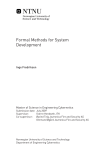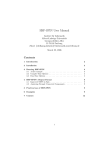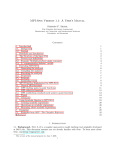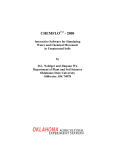Download dsse.ecs.soton.ac.uk - Electronics and Computer Science
Transcript
Some Observations About Using
SPIN and STeP to Verify StAC Specifications
Juan C. Augusto
Michael J. Butler
{jca, mjb}@ecs.soton.ac.uk
Declarative Systems and Software Engineering Group
Technical Report DSSE-TR-2002-9
October 2002
www.dsse.ecs.soton.ac.uk/techreports
Department of Electronics and Computer Science
University of Southampton
Southampton SO17 1BJ, United Kingdom
1
Some Observations About Using
SPIN and STeP to Verify StAC Specifications
Juan C. Augusto
Michael J. Butler
Declarative Systems and Software Engineering Research Group
Department of Electronics and Computer Science
University of Southampton
Southampton, United Kingdom
July 14, 2003
Abstract
Business transactions are prone to failure and to deal with unexpected situations. Some specification languages, e.g. StAC, introduce
notions like compensation handling. Given the importance of verification of correctness in business related software, it is important to fill in
the gap between specification languages like StAC and the verification
software already available.
We report on two of our previous attempts to develop a tool to
allow verification of StAC secifications by using already existing systems. One such attempts involved SPIN and its specifcation language,
Promela. The other case involves STeP and its specification language,
SPL. We focus on the problems we faced during these attempts, because they can prevent successful and widespread use of verification
tools. Our experience can be used to make the available tools more
versatile and hence, useful to a wider range of applications.
2
Contents
1 Introduction
4
2 StAC
5
3 Translating StAC to Promela
3.1 Coordinating Nested Procedures
3.1.1 Sequential Invocations .
3.1.2 Parallel Processes . . . .
3.1.3 Conditional Calls . . . .
3.1.4 Recursive Calls . . . . .
3.2 Generalized Parallel . . . . . . .
3.3 Early Termination . . . . . . .
3.4 Handling of Compensations . .
3.5 Optional Labels . . . . . . . . .
.
.
.
.
.
.
.
.
.
.
.
.
.
.
.
.
.
.
.
.
.
.
.
.
.
.
.
4 Translating StAC to SPL
4.1 Recursive Specifications . . . . . . .
4.2 Handling Enumerates . . . . . . . . .
4.3 Flexibility on Generalized Operators
4.4 Early Termination . . . . . . . . . .
4.5 Obtaining Counterexamples . . . . .
4.6 Proving Temporal Properties in STeP
.
.
.
.
.
.
.
.
.
.
.
.
.
.
.
.
.
.
.
.
.
.
.
.
.
.
.
.
.
.
.
.
.
.
.
.
.
.
.
.
.
.
.
.
.
.
.
.
.
.
.
.
.
.
.
.
.
.
.
.
.
.
.
.
.
.
.
.
.
.
.
.
.
.
.
.
.
.
.
.
.
.
.
.
.
.
.
.
.
.
.
.
.
.
.
.
.
.
.
.
.
.
.
.
.
.
.
.
.
.
.
.
.
.
.
.
.
.
.
.
.
.
.
.
.
.
.
.
.
.
.
.
.
.
.
.
.
.
.
.
.
.
.
.
.
.
.
.
.
.
.
.
.
.
.
.
.
.
.
.
.
.
.
.
.
.
.
.
.
.
.
.
.
.
.
.
.
.
.
.
.
.
.
.
.
.
.
.
.
.
.
.
.
.
.
.
.
.
.
.
.
.
.
.
7
9
10
11
12
12
13
17
19
20
.
.
.
.
.
.
21
24
24
25
26
26
27
5 Conclusions and Further Work
28
A STeP Diagram
31
B Counterexample for a Specification in STeP
32
3
1
Introduction
Business transactions, because of their complexity, are prone to failure in
many ways. For example, a request that normally is satisfied under certain
conditions can be unexpectedly rejected. That can be experienced in daily
life when the book we requested is not anymore in stock, when our trip is
cancelled, or when an appointment we scheduled cannot be made effective.
However systems are normally built considering the normal and expected
pattern of behavior from their many constituent parts. A way to deal with
this conflict is to supplement that expected pattern of behavior with mechanisms that allows the system to react more appropriately when an unexpected/undesired event of this sort occurs. One such mechanisms proposed
in the literature is the one of designing ways of compensating an action with
a set of actions, that will repair or handle in some appropriate way that
situation. Offering alternatives and rescheduling can be ways to compensate
previous actions. A business process modelling language proposed to handle
this concept is StAC (see [CGV+ 01] and [BF00]).
However the important issue of how to verify correctness in StAC specifications had not been addressed yet. We report here on our previous attempts
to provide a suitable verification framework for StAC specifications. We considered two systems with different characteristics, SPIN [Hol97] and SteP
[BBC+ 99]. The first option led us to consider a translation from the StAC
specification language to Promela, the input language for SPIN. For the second option we considered instead a translatation to SPL, the input language
for STeP.
We faced several problems preventing us from obtaining an easy to use
verification framework by using any of these tools for the kind of bussines oriented specifications allowed in StAC. Hence we believe it is useful to provide a
detailed explanation of the differences between these two classes of languages
in order to guide future atttempts to verify business related systems.
We shall present our work beginning with a brief introduction to the
main system involved, StAC (section 2). Following, we explain (section 3)
the main obstacles preventing us from obtaining an effective translation from
StAC to Promela. Then we give some details (section 4) about the problems
we faced, both to achieve a translation from StAC to SPL and to use STeP at
the verification stage. We finish this report with our conclusions (section 5)
about how this experiences can lead to an improvement on next generation
verification systems for business related systems.
4
2
StAC
StAC (Structured Activity Compensation) is a language that, in addition to
CSP-like operators, [Hoa85] offers a set of operators to handle the notion
of compensation. By this we mean a way to associate to an action a set
of actions, typically one, providing a way to repair an undesired situation.
Compensations are expressed as pairs with the form P ÷ Q, meaning that Q
is the compensation planned in case that the effect of P needs to be compensated at a later stage. As the system evolves, possible compensations are
remembered. Each compensation operator is bounded to a scope of application. If all the activities are successfully accomplished then the operator
accept releases the compensations. If any activity fails, then the operator
reverse orders the system to apply all the recorded compensations.
Definition 1 Let A represent an activity, b a boolean condition, P and Q
two generic processes, x a variable and X a set of values. Then, we can define
as follows the set of well formed formulas in StAC:
Process ::=
|
|
|
|
|
|
|
|
|
|
|
|
|
|
A
0
b→P
rec(P)
P;Q
P ||Q
||x ∈ X.Px
P []Q
[]x
J ∈ X.Px
{P }
P ÷Q
2
√
[P ]
(activity Label)
(skip)
(condition)
(recursion)
(sequence)
(parallel)
(generalized parallel)
(choice)
(generalized choice)
(early termination)
(termination scoping)
(compensation pair)
(reverse)
(accept)
(compensation scoping)
N
We now introduce two scenarios that will be useful to illustrate StAC and
later on we will use as case studies when attempting to provide a verification
framework for StAC. Those processes written in boldface are intended to be
basic activities. Each StAC specification is coupled with a B machine [Abr96]
describing the state of the system and its basic activities. Basically a B machine is composed by a declaration of sets, variables, invariants, initialization
and operations over those structures. Each StAC activity in a specification
will have associated an operation in the corresponding B machine explaining
how that activity is implemented in logical terms, see for example [BF00] .
5
Example 1 First we consider the specification of an order fulfillment scenario presented in [CGV+ 01]. The whole process can be described basically
throughout the following steps: a) an order is accepted from a customer b)
the warehouse prepare the order for shipment, including booking a courier for
delivery c) simultaneously with step (b) there is a credit check to verify the
costumer can pay the order. d) if the check is successful the order completes,
otherwise it is stopped and the compensation mechanism is started. This can,
for example, send a request for unpacking the ordered items. In this case we
consider three items. We also include some variants to the specification given
in [CGV+ 01] which results in a simpler translation process.
abc = (acceptOrder ÷ restockOrder);
fulfillOrder;
√
((okFulfillOrder ; 2 ) [](notokFulfillOrder ; ))
fulfillOrder = {wareHousePackaging ||
(creditCheck ;
J
((notokCreditCheck;
)[](okCreditCheck;0))) }
wareHousePackaging = (bookCourier ÷ cancelCourier) || packOrder
packOrder = || i:{i1, i2, i3}.(packItem(i)÷ unpackItem(i))
M
Example 2 Lets consider the specification of an E-Bookstore, presented in
[BF00]. Here we consider a finite set C of registered customers. Each client
is associated to a limited budget and also has an e-basket where to put the
selected books. Every time the customer selects a book, its price is compared
with the user’s allowed budget. If the price exceeds the credit then it is
returned to the e-shelf. When the customer asks to leave the E-Bookstore,
either s/he pays or the selected books have to be returned to stock.
Bookstore = || c∈C . client(c)
client(c) = arrive(c); chooseBooks(c);
((quit(c) ; ) [] (pay(c);
2 )); exit(c)
√
chooseBooks(c) = checkout(c) [] (chooseBook(c); chooseBooks(c))
chooseBook(c) = []b∈B . [(addBook(c,b) ÷ returnBook(c,b)) ;
overBudget(c) → ]
pay(c) = processCard(c) ; ¬ accepted(c) → 6
Arrive creates and initializes the client information, that includes setting
the appropriate budget. ChooseBooks represents the selection of books by
the customer. Next, the customer is offered either to quit the transaction or
to proceed by buying some items. In the first option the information is cleared
just after the compensation is applied, i.e., after returning the books to the
shelf, and in the second case it will be cleared after accepting the operation.
ChooseBooks, specified as a recursive process, allows the customer to choose
as many books as s/he wants. For each book the customer chooses, it is
checked if that lead to exceed her/his budget. If it does, then the reverse
operator causes the book to be returned to the shelf. Pay has the same effect
in case that checking the credit card is not successful.
M
We address the reader who want a more in-detail account of StAC to
[CGV+ 01] and [BF00]. The first article gives an explanation on how StAC
relates to IBM’s BPBeans enterprise technology and more examples. The
second one also offers an operational semantics and the integration between
StAC specifications and B Machines. Both explore how to consider the notion
of multiple compensation, a feature we do not address in this work.
3
Translating StAC to Promela
Model checking [CES86] can be used to check whether a logical property
holds for a finite-state system. Although extensions of this idea exists for
the case of infinite state systems, we will focus on the finite case during this
work. A particularly successful implementation of this approach is SPIN,
[Hol97] that has been widely accepted as a tool to support the verification
stages in software and hardware development.
It allows a series of useful verification actions in relation to a system specification with emphasis on efficiency. SPIN offers the possibility to perform
simulations and verifications. Through these two modalities the verifier can
detect absence of deadlocks and unexecutable code, to check correctness of
system invariants, to find non-progress executions cycles and to verify correctness properties expressed in propositional linear temporal logic formulae.
Promela is the specification language of SPIN. It is a C-like language enriched
with a set of primitives allowing the creation and synchronization of processes, including the possibility to use both synchronous and asynchronous
communication channels.
We refer the reader to the extensive literature about the subject as well
7
as the documentation of the system at Bell Labs web site 1 for more details,
assuming some degree of familiarity with this framework from now on.
Translating StAC specifications to Promela proved to be a non trivial
matter and, when possible, demanded much more complex data and control
structures to recreate StAC novel features in Promela syntax. At some level
of abstraction and for some operators we can find a relation between some
operators in StAC and some others in Promela. For example, regarding
control structures, we can find the following relations.
- sequence, represented in stack with the symbol “;”, can be modelled with
the same symbol in Promela in the case of basic activities.
- choice of type ((condition1 ; Pr1) [](condition2 ; Pr2)) can be dealt
with by using an if ... fi structure in Promela.
- parallel operator, represented in StAC as “k”, can be implemented in
Promela by running two processes. For example, proc1 k proc2 can
be represented as run proc1() ; run proc2().
A key notion in any non-trivial StAC specification is that one of a nonprimitive process. Basically they are used in the same way as procedures
in high level programming languages. There is no direct way to define
procedures in Promela. However, they can be implemented supplementing
proctype declarations with some coordination mechanisms to ensure their
behavior is synchronized in the same way as expected in StAC. For example,
as invoking processes in Promela means their execution is started then starting sequential processes means that processes can be interleaved instead of
run strictly in sequence. Similar problems can appear in the context of StAC
specifications while using parallel, conditional and recursive operators. We
consider each of these cases with more detail in section 3.1.
- generalized parallel, ||i ∈ S.Pi , demands more work as Promela does not
have a constructor that allows us to directly implement this concept.
However it can be built by combining different concepts already at
hand, i.e. proctypes and some mechanism for synchronization. This
will be explained with more detail in section 3.2.
- Other non-StAC related operators like skip and condition do not pose much
interest from the perspective of this article in the sense they can be
translated straightforwardly to a Promela syntax equivalent.
1
http://netlib.bell-labs.com/netlib/spin/whatispin.html
8
Those operators more specifically related to the compensation notion have
to be handled with special purpose procedures resorting to different Promela
resources.
The early termination operator is applied within a termination scope and
allows to terminate all processes in that scope. However, implementing that
in Promela can be very cumbersome as it does not provide an equivalent concept, especially when we need to terminate parallel processes. We comment
on that problem in section 3.3.
A compensation pair demands remembering what compensation operation has to be applied associated with a particular action. Because compensations are applied in reverse order, [CGV+ 01] pp. 4, it can be implemented
putting into a stack the code identifying the compensation to be remembered.
Given the above mentioned implementation of compensations using a stack
the Accept compensation will pop up elements out the stack forgetting the
compensation while the reverse operator will pop the code from the stack
and call the corresponding compensation action accordingly. However, the
complexity of the information to be stored can turn this into a non trivial
matter, as it will be explained in section 3.4.
It is desirable to have a standard and easy way to refer to special places
or processes in the specification to be verified. One way to do that is to
introduce labels during the translation process into the resulting code in such
a way they can be referred in an easy way inside temporal logic formulas. We
explain in section 3.5 why this is problematic to be implemented in Promela.
3.1
Coordinating Nested Procedures
Calls to non primitive processes in StAC behave as calls to procedures in
programming languages. For example, a sequence of calls to non-primitive
processes in the StAC specification must be executed without interleaving
between them, while their proctype counterparts in Promela will allow interleaving. For example, run P; run Q will start P first and then will start Q
without waiting for P to terminate. Q can be started at any time after P has
been. Then the ; operator in this case does not have the usual semantics for
procedures in high level programming languages as it is the case for StAC.
Synchronization can be achieved as expected in StAC trough a fork &
join mechanism forcing all subprocesses to be finished before the process that
created them is considered finished. Broadly speaking, a way to introduce
this mechanism in the translation is as follows, for every process P calling
other subprocesses p1 , . . . , pn , i.e. implemented as proctype calls through
the run sentence, we can a) add at the end of each pi , with i = 1, . . . n, a
way to acknowledge that the process finished and b) after the call sentence
9
in the caller process a way to recognize that the called processes finished
before proceeding. This is just a simplification to present the general strategy
because there are further subtleties to consider depending on the context
where the call is performed. In addition to sequence and parallel, other
structures affecting coordination of processes invocation are conditionals and
recursive definitions. We devote this section to explain how to deal with these
four options.
Note that the alternative solution to use inline definitions does not work
in the case of recursive definitions, something fairly common in StAC specifications.
3.1.1
Sequential Invocations
for a StAC specification: ... A; B ... we want A to be finished before
starting B at all. To achieve that we supplement A and B with acknowledgments at the end of their definitions and the calls to A and B with tests to
check they have finished. In this way first A will be called and only after its
acknowledge is detected B will be invoked.
Example 3 A sequence ... A; B ... in our framework is translated into
Promela as the following supplemented invocations:
chan ch_A2caller = [0] of {bit}
chan ch_B2caller = [0] of {bit}
proctype A() { ... (main body of A) ...; ch_A2caller!1 }
proctype B() { ... (main body of B) ...; ch_B2caller!1 }
proctype caller()
{ bit doneA=0, doneB=0;
run A();
ch_A2caller?doneA;
do
:: doneA ==1 -> break
od;
run B();
ch_B2caller?doneB;
do
:: doneB==1 -> break
od
}
M
10
It is worth to notice that: (a) this mechanism is independent of the
amount of callers a process has and (b) it is also independent of how many
simultaneous calls a process have because each call from different processes
will generate a dedicated channel to handle their coordination, e.g. like
ch A2caller and ch B2caller in the previous example.
To simplify further explanations on this issue lets assume the following
notational conventions. We keep using the term caller to identify a process
that call others and we introduce the term called for any process that is
called, e.g. A and B in example 3. We call acknowledge the message sent by
a called process to a caller, e.g. ch B2caller!1 in example 3. We represent
by test (Name of Proctype) finished both the channel request and the
do ... od loop waiting for the acknowledge after each call, like those after
run A() and run B() in example 3. By using this terminology we will sketch
how to proceed in other similar cases, namely calls made in the context of
parallel, conditionals and recursive structures.
3.1.2
Parallel Processes
A parallel operator can be used to invoke processes in many ways. Perhaps the situation of two invocations like in A(...) || B(...) is conceptually the easiest to think about. However, it could also happen even
when some or none of the processes involved are actually invocations e.g.
A(...) || Pr and Pr1 || Pr2 where Pr, Pr1, Pr2 can be any legal process in StAC, different from an invocation to a process. If any of the processes
involved in the use of a parallel operator is not an invocation, then has to be
delimited in some way, e.g., A(...) || (Pr1; Pr2) tell us that in parallel
with the invocation to A, a composite processes made up of a sequence of
processes Pr1 and Pr2 is executed. We will call the parallel definition to be
coordinated a block. A block A || B terminates when both A and B terminates. As a difference with the sequential case we want to ensure now that
parallelism is implemented but just restricted to those processes in the block.
In this case the testing for acknowledgments is shifted immediately after the
translation of the intervening processes inside the block.
Example 4 If we consider the case of coordinating a block like
A(...) || B(...) we include “chan ch A2Proc = [0] of bit” as a declaration and generate the following code in a second phase of the translation:
proctype A() {(body of A) ... ch_A2caller!1 }
proctype B() {(body of B) ... ch_B2caller!1 }
proctype caller()
11
{ bit doneA=0;
bit doneB=0;
{ /* begin block */
run A(...); run B(...)
} /* end block */
test_A_finished;
test_B_finished
}
3.1.3
M
Conditional Calls
Calls to a set of procedures can be performed also from “branching” structures, e.g., conditions and choice operators. In such cases, different tests for
termination must be attached to each branch.
Example 5 For example, the following specification in StAC includes the
use of a choice operator: (a=0; (A; B)) [] (a>0; C) where A, B,C are
invocations to non-primitive processes. It can be mapped into the following
Promela code.
if
::
::
fi
3.1.4
a=0 -> run A(); test_A_finished;
run B(); test_B_finished
a>0 -> run C(); test_C_finished
M
Recursive Calls
StAC allows recursive definitions (see definition 1). We can adapt the idea
used in the previous case for conditioned calls to recursive specifications. A
recursive definition can be seen as a special case of choice, offering at each
step either the opportunity to use the termination case or the recursive case.
Termination cases must acknowledge they finished successfully (here that
part of the declaration is acting as a called process) while in the recursive
case a test must be added (having the role of a caller in our initial generic
explanation).
Example 6 Lets consider for example the following StAC specification of a
recursive process A(n):
12
(a=0; finish=true) [](a>0; a=a-1; A(a))
It can be mapped into the following Promela code:
proctype A(short a)
{
if
:: a=0 -> finish=true; acknowledge
:: a>0 -> a=a-1; run A(a); test_A_finished
fi
}
3.2
M
Generalized Parallel
Either if we use a parallel or a generalized parallel, operatorP ARi for short
from now on, we want to ensure that we consider the process finished if and
only if all the processes being run concurrently are finished. Then again
we need to address the coordination problem, we focus in the most general
case, the P ARi operator, because in addition to the coordination problem
it involves issues of legibility when we want to consider a translation. The
number of calls a generalized operator can generate is usually higher than
those made by individual calls scattered throughout the code. Then, using
the same schema than in section 3.1 can result in an uncomfortable writing
for testing termination of called processes.
Example 7 If we translate || i: {i1, i2, ..., in}. A(i)÷ C(i), for
a particular n (we leave that generically specified to emphasize that could be
any finite number), that would lead to the following translation schema:
ch_A(1)2caller?doneA(1);
...
ch_A(n)2caller?doneA(n);
do
:: (doneA(1) ==1 && ... && doneA(n) ==1) -> break
:: else
-> skip
od
M
Becasue number n can be arbitrarily large, then the conditional
(doneA(1) ==1 && ... && doneA(n) ==1) and a long list of receive channel operations can make the resulting Promela code hard to read. Then, the
13
approach that we followed to coordinate common procedures and was useful
in that context is not appropriate anymore. Because we are also interested
on producing a Promela specification that can be directly readable as an
alternative specification for the system under development then we consider
an alternative way to enforce coordination in this cases.
We can generalize the previous approach as follows. We can keep the
acknowledgement procedure for called procedures but to make a more general, and still compact, testing mechanism we can adopt a buffered channel
of an appropriate size to store as many messages as processes will be created. Again what the “appropriate size” is can be collected during the first
of our two-phase translation. In this case the condition of termination is
tested using the full Promela sentence to detect when all processes sent
their acknowledges, i.e., when the buffer has been filled of acknowledgements
messages.
Example 8 Lets assume A is the called process, n is the amount of processes
called by the generalized parallel operator, and a declaration
chan ch A2caller = [n] of bit
has been created after the first phase of the translation. Then, the translation
of the P ARi operator considered in the previous example will be instead:
do
::
::
ch_A2caller?index_ch_A2caller; index_ch_A2caller++
/* fill the queue */
full(ch_A2caller) -> break
/* done
*/
od
M
Observe this problem does not apply to generalized choice because if the
choice involves a procedure call all we need to check is that one call was made
and for that purpose we follow the former strategy.
However, a problem that applies to both, generalized parallel and generalized choice, is that the above described schema assumes that values to be
used with generalized operator are numeric. But, the usual case is to provide
different enumerates for each operator representing names, brands, addresses
and all sort of useful labels motivated by real life applications. So, if a more
flexible set of values has to be used, the limitations to use enumerates in
Promela are evident. Although a special range of constant values can be defined as an enumerate definition using mtype the documentation warns the
14
reader that just one of this definitions can be used on each Promela specification. If all values from all enumerates are put together the practical use
is very limited because there is no implicit type checking performed for each
subtype. Although it is still not implemented a feasible alternative solution,
expensive both in terms of legibility and performance, is to build an enumerate type upon the mtype and the possibility to define new types in Promela.
The following sketch of code illustrates the idea applied to example 2. We
provide constant and variable declarations, then we use the structure in the
translation of parameterized parallel and choice, and finally we provide the
initialization of the structure in the main process. There are two instances of
the more problematic cases of proctypes calls to exemplify the use of the new
proposed structure. One is calling a generalized parallel as when we neeed
to call client inside bookstore and the second is an example of calling a
generalized choice like when we call chooseBook.
/* Constant declarations */
/* how many elements the enumerate type has?
(to be calculated during translation time) */
# define max_enumerate
/* Type declarations */
mtype = {john, mel, java, prolog, xml}
typedef E
{
mtype el[max_enumerate]; /* possible elements
*/
short types[max_enumerate];
/* possible types
bit
}
/* index to current type */
current_type
*/
/* Variable declarations */
E e %
(e is a variable of type E)
/* "enumerate" will have for example the following settings:
15
el
: John mel java prolog
xml ...
types
: 0
1 ...
0
1
1
current_type : 0
to express that the valid enumerate for this call is (john, mel)*/
To implement generalized parallel or generalized choice, the proctype
that is substituting the generalized parallel or generalized choice operator has
to be invoked with e.type instantiated with a number to select the corresponding type. For example, if the following proctype definitions are intended to
replace, respectively, Bookstore = || c∈C . client(c) and chooseBook(c)
= []b∈B . ... in the ebook case study:
proctype callClients(E e)
{
/* in this case we just care about the type of element as the
proceedure will be the same for all those elements */
...
index=0;
do
:: (index < max_enumerate
&&
e.types[index] == e.current_type)
-> run client(e.el[index]);
index++
:: (index < max_enumerate
&&
e.types[index] !== e.current_type) -> index++
:: else
-> break
/* index >= max_enumerate */
od;
...
}
/* to implement generalized choice. */
proctype chooseBook(mtype book)
{
16
/* in this case we need to apply ad-hoc procedures for each
element */
%
Generalized Choice
if
:: book=java
:: book=prolog
:: book=xml
:: else --> printf("error in book type")
if;
... (proceed accordingly)
}
Then the following initialization can be created by the translator to allow
the right interpretation of the enumerate on each call:
init{e.el[0]=john; e.types[0]=0;
e.el[1]=mel; e.types[1]=0;
e.el[2]=java; e.types[2]=1;
e.el[3]=prolog; e.types[3]=1;
e.el[4]=xml; e.types[4]=1;
e.current_type = 0;
run callClients(e);
run chooseBook(e)
}
It can be seen that, altough possible, it demands an involved procedure
to overcome the restrictions imposed in Promela to the use of enumerates.
3.3
Early Termination
J
The early termination operator,
(see example 1 for an illustration of its
use), can be applied to force a process to terminate. Brackets can be
J used to
delimitate the scope for the operator application. For example {P ;
; Q}; R
specifies that after P is executed,
Q will be forced to terminate. This will
J
not affect R. If we apply
toJa parallel process then all the parallel
processes
within
the
scope
of
the
are also terminated. For example, in
J
{(P ;
; Q)||R}||S process R will also be terminated but S will not. We
found that the implementation of this characteristic is particularly problematic in Promela.
17
The closest approach to a solution being the use of the label provided
available in Promela which impose conditions to the executability of a proctype, provided some conditions are fulfilled. Then, the obvious move is to
make dependant the parallel processes on a condition that is falsified as soon
as the early termination operator is applied. A sketch of such a specification
follows:
bool early_termination_caller
proctype called() provided (early_termination_caller == false)
{ ...(called code)... }
proctype caller() {
early_termination_caller = false;
run called();
if
:: (condition1) -> early_termination_caller = true;
goto label_early_termination_caller
:: (condition2) -> ... (code to be used under normal conditions) ...
fi;
label_early_termination_caller: skip
/* it must be the entry point to the acknowledge section */
...
}
init {run caller()}
Conceptually speaking this way to solve the problem is correct but a
note in Promela users’ manual warns the user: " ... provided clauses
are incompatible with partial order reduction ... ". This make
the solution inconvenient from a practical perspective as partial order reduction plays an important role in SPIN efficiency and even in the possibility to
solve a problem or not.
18
3.4
Handling of Compensations
A FIFO structure is used to record compensations, as a result, when the
compensation mechanism is applied they will also be compensated following
that strategy. As the stack used to implement the notion of compensation is
made up of global structures, access to these structures should be coordinated
amongst the various concurrent processes. This prevents other concurrent
processes from attempting to access that shared resource. In Promela there
is a simple and efficient way to forbid interleaving over a set of statements by
using either an atomic{...} or a d step{...} (deterministic step) statement.
The last option although more restrictive on their applications is anyway
suitable for our simple sequence of assignments as well as the more efficient
in terms of verification. More details about the differences between atomic
and d step statements can be found in the online Promela grammar definition.
Example 9 Lets assume P ÷ C is the compensation to be translated and c
is a code assigned during the translation process to represent compensation
C. Then, the resulting translation is just the storing of the compensation code
c into the stack:
d_step{index++;
compensations[index]=c
}
M
Stored codes can be recovered later, if necessary, to know what compensations must be applied and in which order that must be done. Then
each compensation must have an identification and all must be unequivocally
identifiable, i.e. the function relating codes with compensations is bijective.
Otherwise, recovering a code from the compensation stack could lead to the
application of the wrong compensation. To ensure that each compensation
has a different code we need to force each generalized parallel affecting a
compensation pair to generate a disjoint set of codes with respect to those
used in other applications of compensation pairs. But we cannot know in
advance what codes will be required in other parts of the specification.
This could be solved by using a two-phase strategy to perform the translation from StAC to Promela, postponing the assignment of codes for generalized parallel operators at the end of the translation. During the first step,
information is gathered about P ARi operators. In the second stage, the actual writing of the output, we are able to generate the constants, variables
and loops specifically tuned to simulate the different calls that a P ARi operator can produce at run time. In this way we neatly divide the problem in two
19
clearly identifiable stages: a) find out how many different codes are needed
from individual applications of compensation pairs and how many different
codes each compensation pair affected by P ARi operators will generate b)
during the writing phase attach different codes for any use of compensations
affected by P ARi operators.
3.5
Optional Labels
As a part of our research we considered the possibility to generate automatically some set of labels that help to identify clearly when some key states
of the system are holding. This labels are not introduced compulsory in
the translation as there is a tradeoff between the amount of variables in the
Promela specification and the performance of SPIN during the verification
process. Instead, they are offered as options to the user, being allowed to
generate different specialized Promela translations depending on what set of
properties is s/he interested in.
One type of labels that can be set during the verification process are
those we call “location labels”. They are intended to provide a clear indication about different key places in relation with the processes involved in
the specification. For example, in the order fulfillment scenario given in example 1 we may want to check that whenever the fulfillOrder process is
invoked, it will finish. Two location labels can be associated with this aim
checking that always reaching the beginning of fulfillOrder will lead to
reaching the last line of its specification. If there is no clear way to indicate
the process has reached this point then some equivalent code lines have to be
identified with that situation and their use can significantly obscure writing
the temporal formulas for verification.
One tempting approach to explore in order to prevent state explosion
could be by using labels provided in Promela to identify meaningful parts of
the specification. However, there seems to be no way to use these Promela
labels in a useful way at the verification stage. For example, the remote
reference mechanism to refer to the special location L in the only instance of
process main by main[0]@L is not allowed as a valid proposition in the LTL
syntax.
Sometimes it is also useful to have an easy and unambiguous way to state
if during a computation a given process has been started, is being executed or
has finished. The mechanism we use provides an alternative way to “label”
locations, or more generally situations. It can be implemented with a pair
of boolean variables. For a process P we can assume two boolean variables
beginP and endP that are assumed to be initially false. As the first sentence
in process P it can be inserted: d step{beginP=true; endP=false}. Anal20
ogously, at the end of process P it can be inserted: d step{beginP=false;
endP=true}. Then the relation of a process in relation to a computation can
be tracked throughout the values of this two location variables: (f alse, f alse)
holds when the process has not been activated yet, (true, f alse) when it has
been activated and is still active, and (f alse, true) when the process finished
one of its activations. Referring to repeated activations demand to use at
least two of these pairs. For example, to express that the process can be
reinvoked it is necessary to say that after (true, f alse) holds, (true, f alse)
can hold at some future computation.
More interestingly, “compensation labels”, again boolean variables appropriately set, can be added after compensation-related operations. Because
this can be done during translation time and the name of both the action to
be compensated and the compensation itself are known, meaningful names
can be chosen for those variables. In example 2 after generating the code
for compensation ReturnBook an assignment rememberedReturnBook=true
can be set. We can also use this mechanism to highlight the application of
relevant operators like reverse and accept, setting boolean variables like
rememberedReturnBook to false when any of this operators is applied. Then
as part of an investigation to study the proper behavior of reverse we can
built formulae like:
rememberedReturnBook ∧ reverse → 3¬rememberedReturnBook
As we explained before this possibility to post labels must be used carefully because although the translation time is dismissable, the space search
during model checking can be incremented considerably depending on the
amount of labels posted by the user.
4
Translating StAC to SPL
STeP ([BBC+ 99]) is a verification system for reactive systems based in a
deductive approach. The aim of the system is that allowing verification in
a deductive framework allows infinite-state systems to be considered, as opposed to the model-checking technique that only allows finite-state system
verification. STeP provides a collection of tools allowing verification by deduction, sometimes with user interaction. It provides verification rules and
verification diagrams, automated support for proving verification conditions.
Other more specific features related to the deductive framework are: automatic generation of invariants at different levels of complexity, simplification
of equations and conditions, decision procedures and first-order reasoning.
Model checking is also available and is a good complement to the deductive
21
system providing counter examples to false properties. In this case, model
checking is provided in both forms: explicit-state and symbolic. There are
extensions for Real-Time and Hybrid Systems. See Appendix A for a general
diagram of STeP.
A system can be input to STeP as an SPL program or as a Fair Transition
System [MP92]. Systems specified in either of these notations must be given
to STeP as files. A specification file has three parts:
1. declarations (types, values, macros, rewrite rules, and auxiliary variables)
2. axioms (properties that can be assumed by STeP in a verification)
3. properties (the formulas we want to prove true for a program or system)
The syntax of SPL programs follows that of traditional imperative languages such as Pascal. In addition to the basic constructs found in these
languages, SPL supports nondeterminism by means of the selection statement ‘or’ and parallel composition by means of the cooperation statement ||.
Parallel processes can interact through shared variables such as semaphores,
as well as by synchronous and asynchronous channels. Execution of parallel
processes is assumed to proceed by interleaving. An example of a specification as an SPL program for Euclid’s algorithm is given next:
in a,b: int where a > 0, b > 0
local x,y: int where x = a, y = b
out gcd: int l0:
[loop forever do
[ t1: guard x > y do x := x - y
or
t2: guard x < y do y := y - x
or
t3: guard x = y do gcd := x
]
]
An equivalent specification as a transition system follows:
22
Transition System % Euclid’s algorithm
in a,b: int where a > 0 /\ b > 0
local x,y: int
out gcd: int
Initially x = a /\ y = b
Transition t1 Just:
enable x > y
assign x:= x - y
Transition t2 Just:
enable x < y
assign y := y - x
Transition t3 Just:
enable x = y
assign gcd := x
For the sake of space we address the reader interested in specifying systems
using SPL syntax or Fair Transition System notation to [MtSg95], chapter 2.
The specification language for temporal properties to be checked is LinearTime Temporal Logic [MP92].
More documentation about the system, including tutorials, demos for
specific parts of the system and case studies can be found in the web page
for STeP 2 . Some case studies available on-line are: A Ring Based LeaderElection Algorithm, Model Checking the Needham-Schroeder Protocol, A
Round-Robin Bakery Algorithm (all by Calogero Zarba), a Verification of a
DLX Pipeline (by STeP team), A Demarcation Protocol (by Jeff Kamerer), A
split Transaction Bus (by Jeff Kamerer), and The Ricard-Agrawala Protocol
(by Jeff Kamerer).
Now we focus on some of the obstacles we came across while repeating our
previous attempt to achieve automatic translations for verification of StAC
specifications. This time the target language being SPL. We begin enumerating some limitations we found in SPL to represent all the concepts required
in StAC, e.g. using recursive specifications (section 4.1), handling enumerates (section 4.2), using generalized
parallel or generalized choice (section
J
4.3) and implementing the
operator (section 4.4). Later on we consider
some undesirable features we found while using some of the tools provided
in STeP. In section 4.5 we comment on some problems we found using the
model checker.
2
http://www-step.stanford.edu/
23
4.1
Recursive Specifications
Because “the parser just plugs in the bodies of procedures when it finds a
procedure call” ([MtSg95], pp. 29), recursion cannot be used as needed in
StAC. To overcome that we have to resort to an equivalent translation, e.g.
a While-like loop. Lets consider the specification of chooseBooks, a process
allowing a customer to choose 0, 1, 2 or more books:
chooseBooks(c) = checkout(c) [] (chooseBook(c); chooseBooks(c))
It cannot be directly translated to SPL as a recursive procedure but instead it could be written in an equivalent way as an iterative procedure.
Following we sketch a possible solution that works for tail-recursive specifications. As a part of the translation we introduce a boolean variable
act checkout that is assigned values nondeterministically (first sentence)
representing the possible choice of any customer to leave the process, even
without choosing a book:
[act checkout := true or act checkout := false];
while (∼ act checkout) do
[ chooseBook(c);
[act checkout := true or act checkout := false]
]
4.2
Handling Enumerates
SPL does not allow repetition of enumerate values and that can be problematic to check types for input data in our specifications. For example, lets
consider that in our ebook case study we sometimes need to refer to different
sets of books under different considerations, say by subject or by alphabetic
order. Then we may need different types:
type Subject_CS
type Subject_Fiction
type Alpha_Order
= {java, prolog, xml}
= {...}
= {..., java, ..., prolog, ..., xml, ...}
but in SPL we are forbidden to specify Subject CS and Alpha Order
because they have some elements in common. Should we need to create
an enumerate with a combination of previous enumerate definitions then we
need to resort to conventions or mappings to overcome the limitation. For
example, one possibility in SPL is to encode enumerates numerically and
treat them consistently throughout the specification. Below we use subrange
declarations to replace the enumerate subtypes:
24
type Subject_CS
type Subject_Fiction
type Alpha_Order
= {1..3}
% 1 = ’java’
% 2 = ’prolog’
% 3 = ’xml’
= {4..7}
= {1..7}
Although uncomfortable still this make feasible to deal with StAC specifications using variables, but as a result
• we need to consider this issues during the translation introducing caselike sentences to map strings to numerical codes and viceversa. For
example, when a compensation has to be applied or when feedback has
to be given to the user.
• the resulting SPL translation is more difficult to read and modify.
4.3
Flexibility on Generalized Operators
SPL do not allow to use non-numeric enumerate values in generalized choice
and parallel. For example, we cannot use:
[or O[c:[java..xml]] ::
...
Again we have to resort to encodings, mapping strings into numbers and
use the numbers as a metaphor of the real information with the same negative
consequences than in the previous step.
Also, although is not clear form the documentation why, using generalized
choice in SPL seems to be computationally expensive. For example in the
ebook case study we would like to use a compact specification like:
or O[c:[1..2], b:[4..6]] ::
[proc_addBook(c,b)];
but changing that specification by the equivalent
[crandom := 1 or crandom := 2];
[brandom := 4 or brandom := 5 or brandom := 6];
proc_addBook(crandom,brandom);
made the difference between the model checker being not or being able
to finish the diagnosis.
25
4.4
Early Termination
SPL does not provide any constructor that can help to implement the early
termination operator. There is nothing in SPL syntax similar to the label
provided available in Promela to impose conditions on the executability of
a process.
This force us to implement that notion by using especial structures and
procedures to represent that notion when using STeP. Means to detect when
a concurrent process has finished must be implemented by using a structure
where to store inter-related processes and conditions of termination have to
be inserted inside inter-related processes to make their executions threads
dependent on each others computations.
4.5
Obtaining Counterexamples
Interpreting a counterexample given by the model checker is a very involved
process as steps provoking the unexpected situation are explained in terms
of internal variables acting as indirect references to the user’s structures. To
illustrate this we consider a small specification involving a permanent loop.
We just have one procedure without parameters, p, when the procedure is
called the conditions for going out of the while loop are never met:
local b: bool where b = false
local end: bool where end = false
procedure p()
[ b :=true;
while b do b:=true;
end := true
]
p()
So asking if the location where variable end is assigned true could ever be
reached will produce the model checker to give a counterexample as answer.
The counterexample provided by STeP is included in Appendix B.
There seems to be no syntax explanation in any of the publicly available
documentation for the system. This force users to have a deep knowledge of
all the theoretical framework underlying the proposal in order to be able to
understand a counterexample.
26
4.6
Proving Temporal Properties in STeP
After finding a way to map the characteristics of StAC specification language to SPL we were able to prove temporal properties characterizing the
behaviour of the original StAC specification. We list below some safety and
liveness properties we investigated for the ebook case study:
% Safety Properties ---------------------------------------% (1 is the encoding for "John" and 2 for "Mel")
% (4 is the encoding for "Prolog", 5 for "Java" and 6 "XML")
% it is true that
% "No decision is made until the system is certain
% about a successful transaction"
[](!((accept[1] \/ reverse[1]) /\ (<> act_processCard[1])))
% it is true that
% "The system cannot proceed with the credit card
% transaction and still being allowed to choose books"
[](!(!(act_checkout[1]) /\ act_processCard[1]))
% it is false that
% "It is not possible to deal with more than one costumer
% at a time"
[](!( act_arrive[1] /\ act_arrive[2]))
% it is true that
% "at least one authorized customer is allowed to operate"
<>(act_arrive[1])
% it is false that
% "no unauthorized customer are allowed to operate"
<>(act_arrive[3])
% Liveness properties ------------------------------------% Notice: ’[] (A --> B)’ becomes ’A ==> B’ in STeP notation
% it is true that
% "Each customer is forced to leave the system either by
% releasing all items on her/his basket or by paying"
act_checkout[1] ==> (<> (act_quit[1] \/ enteredPay[1]))
27
% it is true that
% "If the transaction was not successful at some point the
% acceptance operator should not be applied at any time"
((<> ~okprocessCard[2]) ==> ([] ~accept[2]))
% it is true that
% "No books are returned except in case of exceeding the
% allowed budget"
[] (!(e=(1,4) \/ e=(1,5) \/ e=(1,6))) Awaits (act_overBudget[1])
% it is false that
% "Each customer is forced to do a transaction"
act_arrive[1] ==> (<> act_processCard[1])
5
Conclusions and Further Work
We focused on the translation process from StAC specifications to Promela
and SPL the input languages for SPIN and STeP, respectively. For the
first attempt, using SPIN, we found many problems to map a high level
language as StAC to the structures provided in Promela. A translation is
feasible and for specifications which does not involve parameters and the early
termination, the translation can be used to do some basic verification. That
may include temporal formulas depending on the length of the specification
considered. However, for case studies like the ebook, and possibly many or
the majority of real StAC specifications, parameters are needed and then
complexity of translation and space exploration of the resulting model check
process will increase up to an undesirable level.
SPL is more similar to StAC in structure so we faced less problems trying
to match both languages. In the declaration section, even when enumerates
are not so flexible as we may expect, we can write different enumerates.
About the general structure of the specificatoin we also have some improvements because procedures are handled in much the way we intend them to
be in StAC so we do not need to think about synchronization issues and
that make the resulting code clearer and shorter. Some StAC constructs are
mapped quite straightforwardly into equivalent SPL sentences. Probably the
two more important examples of this are the generalized parallel and generalized choice operators. Still we are faced with some problems to handle
specifications with variables due to restrictions imposed over data types. In
this case many problems arise from the lack of documentation and support
available for the system. It is also problematic to interpret counterexam28
ples in STeP. In order to make easier the comparison between both SPIN
and STeP we focused in the model checking facilities of STeP although it
has to be said STeP is a deduction-based verification environment and the
model checking facilities are provided mainly as a complement to the theorem
prover. Still the translation procedure from StAC to SPL need more research
and has not been actually implemented so there could be more drawbacks to
discover during that stage.
Although none of the tools were completely satisfactory for our goals, we
found SPIN more satisfactory as the environment to work with while the
specification language for STeP was closer to our needs.
Acknowledgments
We would like to thanks to Carla Ferreira for her contributions in relation
with StAC specifications.
29
References
[Abr96]
J. Abrial. The B-Book: Assigning Programs to Meanings. Cambridge University, 1996.
[BBC+ 99] N. Bjorner, A. Browne, M. Colon, B. Finkbeiner, Z. Manna,
B. Sipma, and T. Uribe. Verifying temporal properties of reactive systems: A step tutorial. Formal Methods in System Design,
16:227–270, 1999.
[BF00]
M. Butler and C. Ferreira. A process compensation language. In
IFM’2000 - Integrated Formal Methods, volume 1945 of LNCS,
pages 61–76. Springer Verlag, 2000.
[CES86]
E.M. Clarke, E.A. Emerson, and A.P. Sistla. Automatic verification of finitestate concurrent systems using temporal logic specifications. ACM Transactions on Programming Languages and
Systems, 8(2):244–263, 1986.
[CGV+ 01] M. Chessell, C. Griffin, D. Vines, M. Butler, C. Ferreira, and
P. Henderson. Extending the concept of transaction compensation. Technical Report. Declarative Systems and Software Engineering Research Group, Dept. of Electronics and Computer
SCience, University of Southampton. To appear in IBM Journal
of Systems and Development, 2001.
[Hoa85]
C. A. R. Hoare. Communicating Sequential Processes. PrenticeHall, 1985.
[Hol97]
Gerard Holzmann. The spin model checker. IEEE Trans. on
Software Engineering, 23(5):279–295, 1997.
[MP92]
Z. Manna and A. Pnueli. The Temporal Logic of Reactive and
Concurrent Systems (Specification). Springer Verlag, 1992.
[MtSg95] Zohar Manna and the STeP group. STeP: The Stanford Temporal Prover (Educational Release), User’s Manual. Technical
report, 1995. STAN-CS-TR-95-1562, Computer Science Department, Stanford University. 138 pages.
30
A
STeP Diagram
Figure 1: STeP Diagram
31
B
Counterexample for a Specification in STeP
The states of the modelchecker are valuations of the following variables:
B[0] - b
B[1] - end
I[0] - pi0
The propositional temporal formula to verify is
(<>x1)
where
ATOMS
x1 = (B[1]);
(This formula might differ from the given formula.
Conjuncts that ensure that is well-formed are added
INPUT
SIZES
BSIZE 2
ISIZE 1
CSIZE 0
FLEX_BSIZE 2
FLEX_ISIZE 1
FLEX_CSIZE 0
RIGID_ISIZE 1
COMP 0
JUST 5
NOFAIR 1
BNAMELIST "b" "end"
INAMELIST "pi0"
HAS_ERR_VAR 0
MODULE
INITIAL_COND
32
if necessary.)
BOUNDS
VAR (B’[0])
VAL false
VAR (B’[1])
VAL false
VAR (I’[0])
VAL 0
RELATION true
TRANSITIONS
TRANSITION "$1_7"
FAIRNESS_COND: JUST
TRANSITION_REL:
DISJUNCT 0
ENABLING_COND
((I[0]) = 0)
MODIFYING_REL
BOUNDS
VAR (I’[0])
VAL 1
VAR (B’[0])
VAL true
RELATION true
TRANSITION "$5_7"
FAIRNESS_COND: JUST
TRANSITION_REL:
DISJUNCT 0
ENABLING_COND
(((I[0]) = 1) /\ (B[0]))
MODIFYING_REL
BOUNDS
VAR (I’[0])
VAL 2
RELATION true
DISJUNCT 1
33
ENABLING_COND
(((I[0]) = 1) /\ (~(B[0])))
MODIFYING_REL
BOUNDS
VAR (I’[0])
VAL 3
RELATION true
TRANSITION "$3_7"
FAIRNESS_COND: JUST
TRANSITION_REL:
DISJUNCT 0
ENABLING_COND
((I[0]) = 2)
MODIFYING_REL
BOUNDS
VAR (I’[0])
VAL 1
VAR (B’[0])
VAL true
RELATION true
TRANSITION "$6_7"
FAIRNESS_COND: JUST
TRANSITION_REL:
DISJUNCT 0
ENABLING_COND
((I[0]) = 3)
MODIFYING_REL
BOUNDS
VAR (I’[0])
VAL 4
VAR (B’[1])
VAL true
RELATION true
TRANSITION "idle"
FAIRNESS_COND: NONE
TRANSITION_REL:
34
DISJUNCT 0
ENABLING_COND
true
MODIFYING_REL
BOUNDS
RELATION true
ATOMS
x1 = (B[1]);
PROPERTY
(<>x1)
.
The formula does not hold on all the fair computations.
Here is an infinite counterexample:
Path:
----state: {b=F end=F pi0=0} trans: $1_7
state: {b=T end=F pi0=1} trans: $5_7
Loop:
----state:
state:
state:
state:
{b=T
{b=T
{b=T
{b=T
end=F
end=F
end=F
end=F
pi0=2}
pi0=1}
pi0=2}
pi0=1}
trans:
trans:
trans:
trans:
$3_7
$5_7
$3_7
$5_7
The strongly connected component from which this loop was extracted is:
state: {b=T end=F pi0=2}
state: {b=T end=F pi0=1}
35
























































